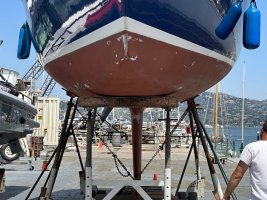I would not be worried about sanding off the gelcoat below the water line. Some premium boats like Swan used to leave the hull below the water line bare (though they had epoxy hulls, not vinyester, but I doubt that makes a difference). In my experience, gelcoat below the waterline is a principle contributor to many cases of blistering, it does little or nothing to protect the substrate laminate from water intrusion despite some folks' imaginations. I would also caution you against slapping coats of barrier coating over any gelcoat that has not been in a dry state for some time. I spent $14K fixing one of my boats because a well known boat yard put a barrier coat over a moist hull and thousands of small blisters were the result. I probably should have ignored them as they had not penetrated any of the resin, but I was new to the boatyard business at the time. I eventually removed all the gelcoat and epoxied the entire hull of that boat and I am still sailing it 32 years later with no new blisters. My guess is that barrier coats have been responsible for as many blisters as they have presented, but they are a business for the boatyards. And kudos to your yard for sanding prior to paining--they must be reputable. The East Coast yards generally slap another coat with nothing more than pressure washing and the older hulls here eventually resemble the surface of the moon and will require some sort of blasting someday to remove the thick crud. They simply do not have time in the busy launch and store season to do things properly. My opinion is that you have nothing to worry about and seem to have a good yard working on your boat. FWIW. Just one opinion.

